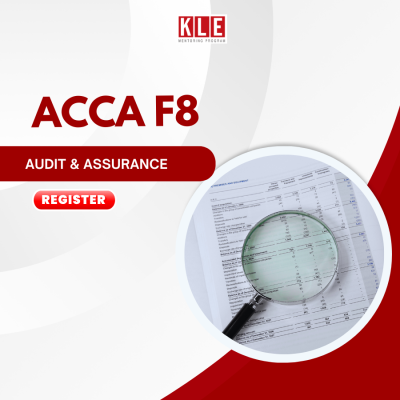Đầu tiên, môn AA/F8 ACCA là một môn học khó, với tỷ lệ đỗ thấp nhất trong các môn thi F trong những năm gần đây (theo thống kê của ACCA). Do đó, việc tự học môn này là tương đối thách thức bởi khối lượng kiến thức nhiều và khá trừu tượng. Để có thể hiểu rõ các vấn đề, người học cần có những trải nghiệm với các case study thực tế thì mới có thể có một cái nhìn rõ nét về mảng kiến thức này. Vì vậy, để rút ngắn thời gian, bạn nên học từ những người đã có kinh nghiệm trong nghề và có khả năng hướng dẫn giải đáp câu hỏi của bạn. Bên cạnh đó, bạn phải chủ động tìm hiểu, tiếp cận với các tài liệu uy tín và kế hoạch học tập hợp lý. Khóa học của KLE sẽ giúp bạn cả 2 khía cạnh này.
1. AA/F8 gồm những nội dung gì?
A – Audit Framework and Regulation: Các quy định và nguyên tắc kiểm toán
B – Planing and Risks Assessment: Lên kế hoạch và đánh giá rủi ro
C – Internal Control: Kiểm soát nội bộ
D – Audit Evidence: Bằng chứng Kiểm toán
E – Review and Reporting: Báo cáo và soát xét
2. Mục tiêu của môn học AA/F8
Để hỗ trợ học viên dễ dàng “pass” môn học này, các bạn sẽ được trang bị để:
- Hiểu đúng khái niệm kiểm toán & các dịch vụ đảm bảo; đạo đức và ứng xử nghề nghiệp.
- Hiểu đúng về khái niệm căn bản của Kiểm toán như Assertion, Risk assessment, Materiality trong thực tiễn thông qua các buổi học lý thuyết và thực hành mô phỏng công việc kiểm toán trên báo cáo tài chính, hiểu rõ và đánh giá các Kiểm soát nội bộ
- Nhận biết các bằng chứng của kiểm toán viên và các cách thức thu thập bằng chứng. Hiểu sâu và có thể áp dụng các kỹ thuật, các thủ tục Kiểm toán cho các phần hành dựa trên việc tuân thủ các Chuẩn mực Kiểm toán Việt Nam (VSA) và Quốc tế (ISA)
- Hiểu đúng về kết luận từ bằng chứng kiểm toán thu thập được và được phản ánh trong báo cáo kiểm toán, các giải trình bằng văn bản, báo cáo và soát xét cuối cùng.
3. Hình thức tham gia thi AA/F8
Mỗi thí sinh có 180 phút để làm bài thi ACCA AA/F8 trên máy tính theo hình thức trắc nghiệm (CBE – Computer Based Exam).
Cấu trúc đề thi AA/F8 gồm 2 phần:
Phần 2 của bài thi sẽ kiểm tra chủ yếu một hoặc nhiều khía cạnh của Ki
9 Bài học - 2 giờ 6 phút
4 Bài học - 0 phút
3 Bài học - 0 phút
14 Bài học - 0 phút
23 Bài học - 0 phút
5 Bài học - 0 phút
7 Bài học - 0 phút
14 Bài học - 0 phút
14 Bài học - 0 phút
12 Bài học - 0 phút
10 Bài học - 0 phút
6 Bài học - 0 phút
14 Bài học - 0 phút
7 Bài học - 0 phút
17 Bài học - 0 phút
7 Bài học - 0 phút
13 Bài học - 0 phút
13 Bài học - 0 phút
8 Bài học - 0 phút
9 Bài học - 0 phút
5 Bài học - 0 phút
8 Bài học - 0 phút
12 Bài học - 0 phút
5 Bài học - 0 phút
2 Bài học - 0 phút
2 Bài học - 0 phút
![]() Training Director, KLE Mentoring Program
Training Director, KLE Mentoring Program
![]() Financial Controller, Đại Việt Group
Financial Controller, Đại Việt Group
![]() Head of Internal Audit Department, Sam Sung
Head of Internal Audit Department, Sam Sung
![]() Audit Manager cum head of Technical and Training Department, Crowe Việt Nam
Audit Manager cum head of Technical and Training Department, Crowe Việt Nam
️![]() Consulting Manager, Audit Assistant Manager, KPMG Việt Nam
Consulting Manager, Audit Assistant Manager, KPMG Việt Nam
![]() CPA Australia
CPA Australia
